|
|
|
Sort Order |
|
|
|
Items / Page
|
|
|
|
|
|
|
| Srl | Item |
| 1 |
ID:
161768
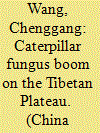

|
|
|
|
|
| Summary/Abstract |
In the last two decades, the Tibetan regions of China have been experiencing a remarkable economic boom fueled by the caterpillar fungus, known in the West as the “Viagra of the Himalayas” or “Tibetan Gold.” This article examines the impacts of the caterpillar fungus boom on Tibetan pastoralists' current-day livelihood and the prospects of their future economic development. Our study is based on a household survey conducted in 2016 covering 58 villages across the Tibetan autonomous land area. Results show that the new stream of cash income from gathering and trading caterpillar fungus has had a strong short-term welfare-improving effect. Household consumption, healthcare spending, and religious charity have risen sharply with caterpillar fungus income. Unfortunately, the fungus boom has not brought about productive investment or human capital accumulation that is conducive to long-term growth. Rather, the resource windfall has created disincentives for school attendance, nonfarm labor participation, and productivity improvements in pastoralism. The resource boom-induced disinvestments, if persistent, will likely further limit the capabilities of rural Tibetans to compete in the urban labor market, reinforcing the emerging trend of socioeconomic marginalization. We contextualize these findings in terms of Tibetans' cultural and economic rationale, pointing out new directions for future research and policymaking.
|
|
|
|
|
|
|
|
|
|
|
|
|
|
|
|
| 2 |
ID:
161776


|
|
|
|
|
| Summary/Abstract |
In response to the One Belt One Road (OBOR) initiative, China's overseas direct investment (ODI), especially whole or majority-ownership mergers and acquisitions, rose significantly in the belt-road countries, especially the ones along the continental route. Comparatively speaking, China's state-controlled acquirers played a leading role in infrastructure sectors, whereas the non-state-controlled acquirers were particularly active in non-infrastructure sectors. Central and West Asia, Western Europe and Russia are favorable destinations of Chinese ODI.
|
|
|
|
|
|
|
|
|
|
|
|
|
|
|
|
| 3 |
ID:
161764
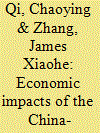

|
|
|
|
|
| Summary/Abstract |
After 21 rounds of intense negotiations over nearly a decade, the deal of China-Australia Free Trade Agreement was finally completed in late November 2014. This paper attempts to examine both the causes and consequences of this delayed conclusion by running simulation experiments on a computable general equilibrium model, to see how the free trade agreement affects the world economy not only on the two countries involved, but also on the rest of the world with a particular reference to New Zealand. Based on the simulation results, policy implications are generated.
|
|
|
|
|
|
|
|
|
|
|
|
|
|
|
|
| 4 |
ID:
161777
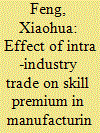

|
|
|
|
|
| Summary/Abstract |
In making use of the panel data in 27 manufacturing industries, this paper examines the recent increase in skill premium in China's manufacturing. The paper argues that the recent increase in skill premium in Chinese manufacturing can be partly attributed to the decline in intra-industry trade. A reasonable explanation on this is that the decline in intra-industry trade occurred in the period studied is associated with a decrease in output. This led to a reduction in relative demand of low-skilled workers, which supports the hypothesis of the output-skill substitutability, and finally an increase in skill premium. Further, this paper finds that the negative effect of intra-industry trade on skill premium is larger for high-skilled manufacturing than low-skilled manufacturing. One more result in this paper is that the increase in capital input reduced the skill premium in Chinese manufacturing. The empirical evidence is consistent with a modified model of intra-industry trade with differentiated products and three factor inputs: high-skilled labor, low-skilled labor and capital.
|
|
|
|
|
|
|
|
|
|
|
|
|
|
|
|
| 5 |
ID:
161773


|
|
|
|
|
| Summary/Abstract |
Fiscal spending has both direct and indirect impact on the environment. Using city-level data in China, this paper investigates if education spending affects air pollution through human capital accumulation, known as the composition effect, and if R&D spending affects air pollution through clean-technology adoption, known as the technique effect. Contrasting theoretical predictions and previous empirical evidence, we find both effects of interest to be trivial in urban China. Composition effect appears to be slightly stronger relative to technique effect, while sub-sample analyses show some regional heterogeneities. The results remain robust when we switch between pollution measurements, examine only the regional central cities, instrument endogenous covariates, and adopt the spatial settings. We further discuss potential channel-blocking mechanisms that lead to weak estimates.
|
|
|
|
|
|
|
|
|
|
|
|
|
|
|
|
| 6 |
ID:
161780


|
|
|
|
|
| Summary/Abstract |
Functional upgrading occurs when a firm acquires more sophisticated functions within an existing value chain. In this paper, we analyze if there is evidence of this type of upgrading in China's export processing regime by investigating dynamics in the relative prevalence of Import & Assembly (IA) versus Pure Assembly (PA) processing trade over the period 2000–2013. Firms in both regimes provide similar manufacturing services to foreign companies, but IA firms also conduct the sophisticated tasks of quality control, searching, financing and storing imported materials. Consistent with a trend of functional upgrading, we show that the share of IA trade in total processing trade has increased rapidly during the period 2000–2006, both overall and within product categories. Furthermore, we find that this trend has gone hand in hand with improvements in a sector's labor productivity and unit values. Against expectations, we find that this process has slowed down notably during the period 2006–2013.
|
|
|
|
|
|
|
|
|
|
|
|
|
|
|
|
| 7 |
ID:
161775
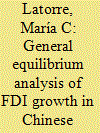

|
|
|
|
|
| Summary/Abstract |
This paper analyzes one of the features of the Chinese economic transition, namely, the impact of foreign direct investment (FDI) accruing to advanced services sectors. To that aim we use an innovative computable general equilibrium (CGE) model that includes, in a multi-regional setting, foreign multinationals operating in monopolistic competition. The model is based on data that split the world economy in 2016 into 11 regions (China - US - EU27 - Great Britain -other advanced economies - India - Japan - South East Asia - Latin America - Middle East - Sub Saharan Africa) and 21 sectors. We provide quantitative evidence on several characteristics of the 21 sectors in China, EU27 and the US, as well as other data on the role of China in the global stage, including its evolution since 2004. Several scenarios focusing on the increase of FDI inflows in services, because of the reduction of its FDI barriers, are simulated deriving short and long run results. We find that the impact of more foreign multinationals in services is positive for China but smaller than the one that had been obtained in other previous studies on FDI in manufactures. This is due to the still limited role of services in the Chinese economy and to a crowding out effect that domestic firms experience after the entry of foreign multinationals. On the whole the impact is, however, slightly positive for China, because manufactures benefit from the entry of foreign services multinationals. The rest of regions are unaffected or benefit very slightly, due to the fact that services production is less export oriented and more devoted to private consumption than in the case of manufactures. However, their manufacturing sectors are slightly harmed by the stronger Chinese competition. Many of them manage to more than offset this latter trend through higher exports or FDI in services directed to China.
|
|
|
|
|
|
|
|
|
|
|
|
|
|
|
|
| 8 |
ID:
161766


|
|
|
|
|
| Summary/Abstract |
This paper studies signaling behaviors in marital matching. As some of males' essential traits for marriage are hardly observable, a high-quality male is motivated to signal. This paper applies a modified Spence signaling model to the marriage market and tests the theoretical implications with survey data from rural China. We find that houses are primary signals in marriage markets in China, which explains both the high homeownership and the large housing sizes. We find 1) marriageable males are twice as much likely to build a house five years before marriage than five years after, while females do not behave the same way, 2) housing size is reflective of males' unobservable characteristics, especially in villages with high interest rates. Males with more social connections, higher income rank and greater wealth build larger houses. And 3) a ten-square-meter larger house reduces a male's probability of singlehood by 0.8% at the age of 30, and enables him to marry a wife 0.1 cm taller.
|
|
|
|
|
|
|
|
|
|
|
|
|
|
|
|
| 9 |
ID:
161778


|
|
|
|
|
| Summary/Abstract |
This paper examines the sources of economic growth and the nature of industrial structure change in China over the past decade, with a comparison to those in Russia. It shows that over the observation period between 1995 and 2008, the Chinese economy was concentrated relatively more in the manufacturing sector and relatively less in the service sector than the Russian economy. In addition, this paper finds that the higher economic growth rate in real GDP and aggregate labour productivity growth between 1996 and 2008 in China than in Russia was broadly based, with most industries contributing to China's better performance. Furthermore, it reveals that the acceleration in economic growth in China in 2003–2008 over 1996–2002 was mainly traced to an increased contribution from the manufacturing sector and to a lesser degree the service sector, while in Russia, it was the service sector, followed by the primary sector driven by the mining and oil and gas extraction industry. These results suggest that the Chinese and Russian economies complement each other, which bodes well for further economic cooperation and trade between the two countries.
|
|
|
|
|
|
|
|
|
|
|
|
|
|
|
|
| 10 |
ID:
161774


|
|
|
|
|
| Summary/Abstract |
China has firmly established itself as the key player in the international trade and investment arena. In recent years, it has surpassed Germany and the United States to become the world’s largest exporter. In addition, it has become the world’s second largest recipient of foreign direct investment (FDI) as well as the largest source of outward FDI (if Hong Kong is included).
|
|
|
|
|
|
|
|
|
|
|
|
|
|
|
|
| 11 |
ID:
161769
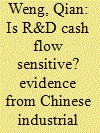

|
|
|
|
|
| Summary/Abstract |
We hypothesize that research and development (R&D) is sensitive to cash flow fluctuations due to asymmetric information and agency problems in the credit market. We adopt a variant of the Q model for R&D investment using the value of the firm, physical capital and employment to capture firm fundamentals as proxies for investment opportunities. We add cash flow to this specification, and estimate the augmented model separately for R&D participation and spending decisions using data on Chinese industrial firms for the period 2001–2006. We find that R&D participation and spending are sensitive to cash flow fluctuations, conditional on firm fundamentals. We also find that the cash flow sensitivity of R&D varies across firms depending on ownership.
|
|
|
|
|
|
|
|
|
|
|
|
|
|
|
|
| 12 |
ID:
161770
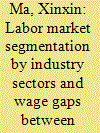

|
|
|
|
|
| Summary/Abstract |
This paper explores the influence of labor market segmentation by industry sectors on the wage gap between rural-to-urban migrants and local urban residents in China in the 2000s. Using Chinese Household Income Project (CHIP) survey data and the results based on the Brown decomposition method, the results indicate that the influence of intra-industrial differentials is greater than the influence of inter-industry differentials in both 2002 and 2013. The influence of the explained component of the intra-industry differentials is larger in both 2002 and 2013, and the influence of the unexplained component of the intra-industrial differentials rises steeply from 2002 to 2013. These results show that the individual characteristic differentials (e.g. human capital) in the same industry sector is the main factor causing the wage gap in both 2002 and 2013, and the problem of discrimination against migrants in the same industry sector became more serious from 2002 to 2013.
|
|
|
|
|
|
|
|
|
|
|
|
|
|
|
|
| 13 |
ID:
161765
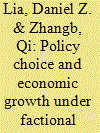

|
|
|
|
|
| Summary/Abstract |
This paper investigates how political elites make policy choices that have bearing on an authoritarian regime's economy, from the perspective of factional politics. A local leader makes policies primarily to secure his political survival, which is contingent on the support from either his higher-level patrons or his local grassroots constituents. Using a simple model, we show that a local politician with close factional ties to high-level patrons will invest more in sending loyalty signals to the latter to receive their protections, while a poorly-connected politician will make more effort to spur a broad-based economic growth that economically benefits his local constituents. Using a unique county level data on the factional politics of Zhejiang Province, China, we find that counties with weaker (closer) factional ties have lower (higher) tax burdens per capita, while spending more (less) on local public goods provision. The results are stable after various robustness tests.
|
|
|
|
|
|
|
|
|
|
|
|
|
|
|
|
| 14 |
ID:
161767
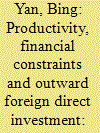

|
|
|
|
|
| Summary/Abstract |
This paper studies the relationship between the financial constraints and outward foreign direct investment (OFDI) of Chinese enterprises. First, we construct a theoretical model and develop a series of hypotheses to analyze how productivity and financial constraints influence firms' OFDI decisions. Then we construct a multivariate index to measure internal and external financial constraints. Using Chinese Industrial Enterprises Database as well as the Database of OFDI Firms in China, our empirical finds that both productivity and financial constraints have important impacts on firms' OFDI decisions. In addition, the marginal effect of the financial constraints increases as firms' productivity rises; an effect felt more to the private enterprises than state-owned enterprises. Empirical results also indicate that external financial constraints affect the firms' OFDI decisions more greatly than the internal financial constraints.
|
|
|
|
|
|
|
|
|
|
|
|
|
|
|
|
| 15 |
ID:
161779


|
|
|
|
|
| Summary/Abstract |
This paper provides a theoretical and empirical analysis of the effects of R&D and financing constraints on the green-sophistication of Chinese firm exports. The theoretical model predicts that firms' R&D expenditure improves the level of green sophistication and financing constraints have moderating effects on firms' the export green-sophistication. The paper constructs an index of the export green-sophistication by incorporating green coefficient in traditional export sophistication. We use the data from the China industrial firm database and confirm our theoretical predictions. The financing constraints are found to have a significant moderating effects on the relationship between R&D and export green-sophistication in basic test and robustness check.
|
|
|
|
|
|
|
|
|
|
|
|
|
|
|
|
| 16 |
ID:
161782


|
|
|
|
|
| Summary/Abstract |
Conceptual definition of an employment includes dimensions beyond the status of a static employed or unemployed dichotomy. Since such a dichotomous measurement of the employment, we are unable to observe structural and qualitative changes of a developing economy during its industrialization process. An improved measure thus is needed to represent the multiple characteristics of employment quality and describe its gradations on the continuum of industrialization process. In this paper, the authors construct and evaluate multi-component variables to measure employment quality in China. The paper also evaluates its validity by using a panel data regression model to examine the changes between 1990 and 2014. The results indicate that employment quality is significantly associated with an industrialization process, while political and institutional barriers constitute major constraints for the development of the employment quality. Policy implications are also discussed in the paper.
|
|
|
|
|
|
|
|
|
|
|
|
|
|
|
|
| 17 |
ID:
161781


|
|
|
|
|
| Summary/Abstract |
This paper aims to investigate China's gains of participating in global value chains (GVCs) in terms of GDP in exports (DVA - domestic value added) and the factors affecting China's gains. The paper decomposes the gross exports of China so as to get the components that make up total GDP in the exports of the country, namely the value-added exports and DVA that are returned from abroad. Then the two components are measured to obtain the scale of GDP in China's exports both on country and sector level. The results show that, firstly, both value-added exports and the GDP in China's exports are less than the traditional gross trade statistics, indicating that there is a gap of real trade gains under GVCs. Secondly, comparing whether the proportion of DVA in total exports, the proportion of DVA in exports of manufactures or the proportion of RDV in total DVA, the gaps between China and the developed countries such as the United States, Germany and Japan do exist. Especially, considering the RDV of China, the proportion is significantly lower than that of major developed countries such as the United States and Germany, indicating that China lags far behind developed countries in the capabilities of supplying high value-added intermediate goods. Lastly, the empirical results suggest that DVA in China's exports has progressively increased in response to the productivity enhancement; research and development (R&D) inputs and capital formation, and the synergies between R&D and vertical specialization affect China's DVA growth in exports positively.
|
|
|
|
|
|
|
|
|
|
|
|
|
|
|
|
| 18 |
ID:
161772


|
|
|
|
|
| Summary/Abstract |
Using a representative sample of rural migrants in cities, this paper investigates where the migrants in urban China come from, paying close attention to intra-provincial vs. inter-provincial migrants, and examining the differences in their personal attributes. We find that migrants who have come from within the province differ significantly from those who have come from outside of the province. Using a nested logit model, we find that overall, higher wage differentials, larger population size, higher GDP per capita, and faster employment growth rate are the attributes of a city that attract rural-to-urban migrants. In addition, moving beyond one's home province has a strong deterrent effect on migration, analogous to the “border effect” identified in international migration studies. We also explore the role of culture, institutional barriers, and dialect in explaining such a pronounced “border effect”.
|
|
|
|
|
|
|
|
|
|
|
|
|
|
|
|
| 19 |
ID:
161771


|
|
|
|
|
| Summary/Abstract |
In this paper, we empirically study the impact of gender identity on the wife's labor supply in China where a high female employment rate and a large population that has a traditional gender identity coexist. We find that the wife's gender identity affects her labor force participation for all cohorts, and the wife's gender identity affects earnings only for rural cohorts. The impact of gender identity varies among generational, regional, and educational cohorts. Husbands still guide their wives, i.e., a husband's gender identity affects his wife's labor force participation and earnings.
|
|
|
|
|
|
|
|
|
|
|
|
|
|
|
|
|
|
|
|
|